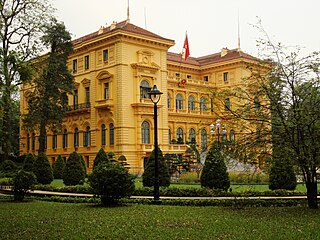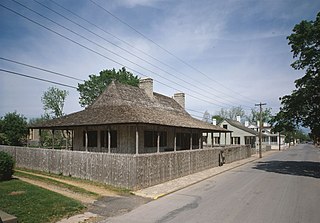
Ste. Genevieve is a city in Ste. Genevieve Township and is the county seat of Ste. Genevieve County, Missouri, United States. The population was 4,999 at the 2020 census. Founded in 1735 by French Canadian colonists and settlers from east of the river, it was the first organized European settlement west of the Mississippi River in present-day Missouri. Today, it is home to Ste. Genevieve National Historical Park, the 422nd unit of the National Park Service.

Timber framing and "post-and-beam" construction are traditional methods of building with heavy timbers, creating structures using squared-off and carefully fitted and joined timbers with joints secured by large wooden pegs. If the structural frame of load-bearing timber is left exposed on the exterior of the building it may be referred to as half-timbered, and in many cases the infill between timbers will be used for decorative effect. The country most known for this kind of architecture is Germany, where timber-framed houses are spread all over the country.

The American Bottom is the flood plain of the Mississippi River in the Metro East region of Southern Illinois, extending from Alton, Illinois, south to the Kaskaskia River. It is also sometimes called "American Bottoms". The area is about 175 square miles (450 km2), mostly protected from flooding in the 21st century by a levee and drainage canal system. Immediately across the river from St. Louis, Missouri, are industrial and urban areas, but nearby marshland, swamps, and the Horseshoe Lake are reminders of the Bottoms' riparian nature.

The Parlange Plantation House is a historic plantation house at Louisiana Highway 1 and Louisiana Highway 78 in Pointe Coupee Parish, Louisiana. The plantation is a classic example of a large French Colonial plantation house in the United States. Its construction date is disputed. Oral history indicates a date of c. 1750 for both establishment of the plantation and construction of the house. Scholarly works accept the establishment date only, having found strong evidence for a construction date from 1830-1840.

The Church of the Holy Family is a Roman Catholic church located at 116 Church Street in the St. Clair County, Illinois city of Cahokia Heights. Built beginning in 1786, it is a remarkably unaltered example of the French colonial construction style known as "poteaux-sur-solle" (post-on-sill), and one of the few such buildings surviving in North America. It was declared a National Historic Landmark and added to the National Register of Historic Places in 1970. The occupying congregation is the oldest continuously active Catholic Parish in the United States, having been founded in 1699 by Canadian missionaries, and the oldest church west of the Allegheny Mountains. At the invitation of Bishop Edward Braxton, the Institute of Christ the King Sovereign Priest continues to offer Mass in this historic church according to the Missal of 1962. Visitors are also welcome for guided tours in the summer. In celebration of the 2018 Illinois Bicentennial, Holy Family Church was selected as one of the Illinois 200 Great Places by the American Institute of Architects Illinois component.

French colonial architecture includes several styles of architecture used by the French during colonization. Many former French colonies, especially those in Southeast Asia, have previously been reluctant to promote their colonial architecture as an asset for tourism; however, in recent times, the new generation of local authorities has somewhat "embraced" the architecture and has begun to advertise it. French Colonial architecture has a long history, beginning in North America in 1604 and being most active in the Western Hemisphere until the 19th century, when the French turned their attention more to Africa, Asia, and the Pacific.

Poteaux-sur-sol is a style of timber framing in which relatively closely spaced posts rest on a timber sill. Poteaux-en-terre and pieux-en-terre are similar, but the closely spaced posts extend into the ground rather than resting on a sill on a foundation, and therefore are a type of post in ground construction. Poteaux-sur-sol is similar to the framing style known in the United Kingdom as close studding. Poteaux-sur-sol has also, confusingly, been used for other types of timber framing which have a sill timber such as post-and-plank, but this is considered incorrect by some scholars.
Pierrotage is a half-timbered timber framing technique in which stone infill is used between posts. It was used in France and by French settlers in French Canada and Upper Louisiana.

The method of building wooden buildings with a traditional timber frame with horizontal plank or log infill has many names, the most common of which are piece sur piece, corner post construction, post-and-plank, Ständerbohlenbau (German) and skiftesverk (Swedish). This traditional building method is believed to be the predecessor to half-timber construction widely known by its German name fachwerkbau which has wall infill of wattle and daub, brick, or stone. This carpentry was used from parts of Scandinavia to Switzerland to western Russia. Though relatively rare now, two types are found in a number of regions in North America, more common are the walls with planks or timbers which slide in a groove in the posts and less common is a type where horizontal logs are tenoned into individual mortises in the posts. This method is not the same as the plank-frame buildings in North America with vertical plank walls.

The Louis Bolduc House, also known as Maison Bolduc, is a historic house museum at 123 South Main Street in Ste. Geneviève, Missouri. It is an example of poteaux sur solle ("posts-on-sill") construction, and is located in the first European settlement in the present-day state of Missouri. The first historic structure in Ste. Genevieve to be authentically restored, the house is a prime example of the traditional French Colonial architecture of the early 18th century in North America and was designated in 1970 as a National Historic Landmark.

The Ste. Genevieve National Historical Park, established in 2020, consists of part or the whole of the area of the Ste. Genevieve Historic District, which is a historic district encompassing much of the built environment of Ste. Genevieve, Missouri, United States. The city was in the late 18th century the capital of Spanish Louisiana, and, at its original location a few miles south, capital of French Louisiana as well. A large area of the city, including fields along the Mississippi River, is a National Historic Landmark District designated in 1960, for its historically French architecture and land-use patterns, while a smaller area, encompassing the parts of the city historically important between about 1790 and 1950, was named separately to the National Register of Historic Places in 2002.

The Guibourd House, also known as La Maison de Guibourd, is an example of poteaux-sur-solle sealed with bouzillage construction. The structure was built around 1806 and was the home of Jacques Jean Rene Guibourd and his family.

Wattle and daub is a composite building method used for making walls and buildings, in which a woven lattice of wooden strips called "wattle" is "daubed" with a sticky material usually made of some combination of wet soil, clay, sand, animal dung and straw. Wattle and daub has been used for at least 6,000 years and is still an important construction method in many parts of the world. Many historic buildings include wattle and daub construction.

A post in ground construction, also called earthfast or hole-set posts, is a type of construction in which vertical, roof-bearing timbers, called posts, are in direct contact with the ground. They may be placed into excavated postholes, driven into the ground, or on sills which are set on the ground without a foundation. Earthfast construction is common from the Neolithic period to the present and is used worldwide. Post-in-the-ground construction is sometimes called an "impermanent" form, used for houses which are expected to last a decade or two before a better quality structure can be built.

Missouri French or Illinois Country French also known as français vincennois, français Cahok, and nicknamed "Paw-Paw French" often by individuals outside the community but not exclusively, is a variety of the French language spoken in the upper Mississippi River Valley in the Midwestern United States, particularly in eastern Missouri.

Le Grand Village Sauvage, also called Chalacasa, was a Native American village located near Old Appleton in Perry County, Missouri, United States.
St. Michel is an abandoned village located in Madison County, Missouri, United States. St. Michel is now incorporated into Fredericktown.

American historic carpentry is the historic methods with which wooden buildings were built in what is now the United States since European settlement. A number of methods were used to form the wooden walls and the types of structural carpentry are often defined by the wall, floor, and roof construction such as log, timber framed, balloon framed, or stacked plank. Some types of historic houses are called plank houses but plank house has several meanings which are discussed below. Roofs were almost always framed with wood, sometimes with timber roof trusses. Stone and brick buildings also have some wood framing for floors, interior walls and roofs.

The Nicolas Janis House, also known as the Green Tree Tavern or Greentree Tavern or as the Janis-Ziegler House, is a poteaux-sur-sol French colonial style house that was built circa 1790-1791 in Ste. Genevieve, Missouri. It is the oldest verified house in Missouri by dendrochronology. The house is listed in the National Register of Historic Places as a part of the Ste. Genevieve Historic District. It is a component of the Ste. Genevieve National Historical Park, a unit of the National Park Service.






















